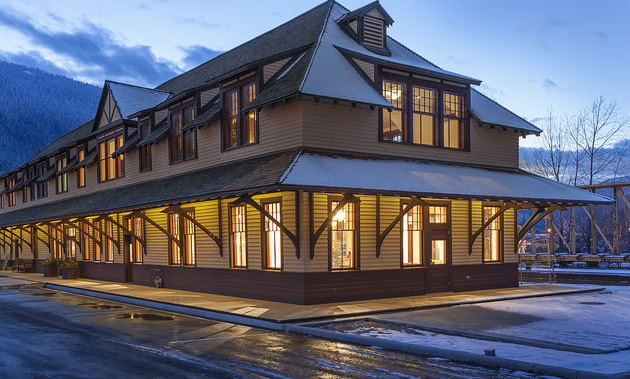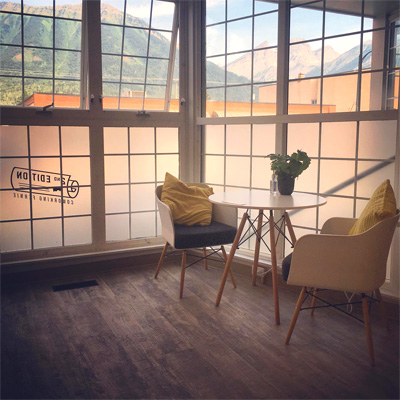Nelson Chamber of Commerce settles into new heritage home
A look into the past and future of the newly restored CP Rail station house.

The exterior of the new Regional Visitor Gateway restored to its original form after four years of hard work and dedication. The project cost $3.5 million and is the new home of the Nelson Chamber of Commerce. — Karen Redfern photo
It's one thing to take on the restoration of a 10,000-square-foot heritage building and another to see the end in sight, within the projected time frame no less. Yet this is exactly what the Nelson Chamber of Commerce succeeded in doing when it moved into the newly restored and improved CP Rail station house — now called the Regional Visitor Gateway (RVG) Business Opportunity Centre — last month.
The massive project, which cost approximately $3.5 million, swung into motion in 2010 when the chamber decided to purchase the building and begin the arduous process of architectural conservation required when working with designated heritage buildings.
"The scope of the work required was extensive as the building had been boarded up for more than 20 years," said Tom Thompson, executive director of the chamber of commerce.
While he admits that many people would have turned away from the project because of the potential liability of the building the chamber felt differently.
"Our board had the feeling the building was an asset and if it took us 15 or 20 years to complete it so be it," said Thompson.
In 2014, after having owned the building for almost four years, the chamber made the decision to sell the building they had been occupying on Hall Street in order to utilize the assets and dive fully into the restoration and construction.
The original station house was built around 1900 and the task of bringing it back to life was given to Joern Wingender, owner of Traditional Timber Framing Co., a Nelson-based company specializing in timber frame restoration.
"This project is basically the amalgamation of different projects I have take on in the past," said Wingender. "The three legs of Traditional Timber Framing are restoration assessments and execution, rehabilitation and natural building. The railway station embodies all three."
By using a mix of old-world building practices and modern technology, Wingender was able to tackle some of the building's biggest issues while "bringing it into the 21st century," Wingender said.
The walls were out of plumb, the doors weren't level and, according to Wingender, being inside gave one a "feeling of seasickness." And so the decision was made to thicken the walls, which solved a handful of problems with one, not-so-simple solution.
Part of this process involved the making of wood chip clay bricks, a process that Wingender had seen used in a timber frame house he visited in Pennsylvania that was constructed in 1773. The bricks, made from wood waste from Harrop-Proctor Forest Products and clay from the Castlegar area, were made on site using a low-tech mechanical press — the only one of its kind in North America.
"By increasing thickness we were able to straighten the walls, add insulation, move the existing windows inside and put storm windows on the outside to protect them," said Wingender, adding that the long-term vision was to "minimize future maintenance cost to the clients."
One of the major challenges of the project was funding, which forced the chamber to work in waves as funds were made available. One way the chamber dealt with this was to enlist the help of the provincial Job Creation Program (JCP). The JCP provides underemployed individuals an opportunity to get back in the work force — in this case learning skills in the construction industry. Thompson said that some of those employed through the program went on to regular employment with local contractors and some decided to enrol in a trades program at Selkirk College.
Other sources of funding came from a mortgage obtained by the chamber, the Columbia Basin Trust, the City of Nelson, the Regional District of Central Kootenay, CP Rail and the Interior Lumber Manufacturers Association.
The RVG is major part of a broader downtown and waterfront renewal project the City of Nelson is embarking on called the Downtown Waterfront Master Plan. Part of the plan is to redevelop underutilized industrial property on the west end of Baker Street and the RVG is considered a cornerstone of this work.
Aside from the chamber of commerce, the RVG will house a tourism visitor centre, the Nelson Economic Development Partnership, Invest Kootenay, Nelson Kootenay Lake Tourism, Black Press and Railtown Coffee.
The hope, said Tompson, is that the RVG will create economic spinoffs throughout the West Kootenay region by providing a year-round tourism hub rich in heritage history that can promote other communities in the area.
"The restoration just adds to Nelson and the area's extensive heritage inventory and helps showcase our community and the entire area when visitors drop in."
While there is still some work being done and roughly 2,500 square feet of space up for consideration, the vast majority of the project is completed and Thompson couldn't be happier with the chamber's new home.
"It's absolutely fantastic," he said. "We love it."





Comments